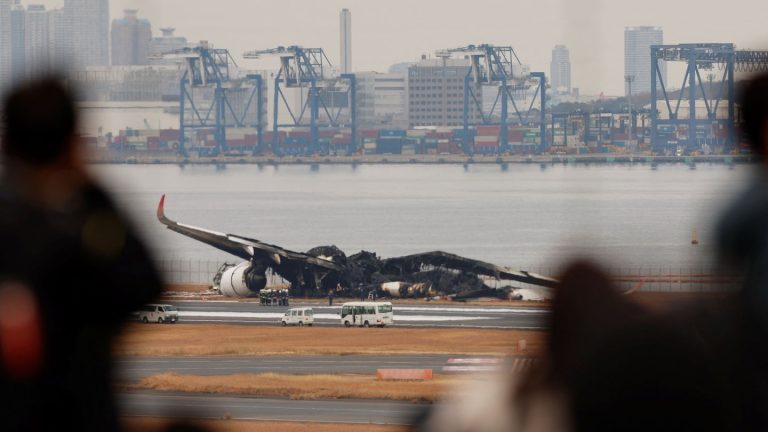Japanese officials are still investigating the cause of the accident, but aviation safety experts say the role of the flight crew, improvements in aircraft safety designs and, most importantly, the way passengers interacted were all key to helping them evacuate safely.
“I think the crew did a fantastic job,” Ed Galea, a professor and head of the Fire Safety Engineering Group at the University of Greenwich in London, said in an interview on Wednesday. He noted that the crew members were working under particularly difficult conditions because the plane's nose was facing down on the runway, meaning passengers departing from the back may have had to walk at a steep angle, while those using the front exits were walking on a slope. .
However, the evacuation was completed within 20 minutes of the plane landing and catching fire, according to the Japan Airlines CEO.
A flight attendant for an international airline based in Asia, who spoke on condition of anonymity because he was not authorized to speak to the media, described the incident as a “model of a perfect evacuation.”
He added that having a “well-trained crew and well-behaved passengers” is essential to successfully evacuate the aircraft in an emergency.
Witnesses described experienced flight attendants directing passengers with relative calm. “When the plane stopped, in less than one minute, the cabin was filled with smoke,” Aruto Iwama told Reuters news agency. “There was screaming, but most people were calm and remained in their seats, sitting and waiting. I think that's why we were able to escape so smoothly.”
Another passenger, Satoshi Yamaki, told Reuters, “The flight attendants asked us to remain calm and asked us to get off the plane.” He added that only 10 to 15 minutes after the passengers moved away from the plane, the entire plane caught fire.
“I heard an explosion about 10 minutes after we got off the plane. “I don’t think we would have been able to survive if we had evacuated the population later,” Tsubasa Sawada (28 years old) said, according to Reuters. “All I can say is that it was a miracle. “
The flight attendant told The Washington Post that the fact that it was a Japanese domestic flight may have made the evacuation easier; Most passengers spoke the same language, making it easy to understand and comply with instructions. Japanese passengers are also likely well-trained in hazards and evacuation due to preparedness for natural disasters common in the country. An Australian official told Sky News Australia that there were about a dozen citizens of that country on the commercial flight as well.
“It is not at all common for passengers to adhere to instructions, although some countries do better than others, and it mostly depends on… their sense of crisis awareness,” the flight attendant said.
But aviation safety experts say the “really important” factor that aided the evacuation involved passengers from all countries, which was the fact that people appeared to have left without taking their luggage.
Galea said that in most accidents, especially those that occur in Europe and the United States, passengers try to take their luggage with them. In the footage of this trip, Galia said: “I did not see a single person carrying his luggage, not a single person.”
Adrian Young, an aviation safety consultant, said that most passengers automatically retract their bags as soon as they land. But this would delay the escape of other passengers by precious seconds.
From the available footage, it also appears that only some cabin doors were opened, Galea said, suggesting that the flight crew took the essential step of ensuring there was no fire around the exits passengers were using, as would have been the case in a plane crash. 1985 Airplane disaster in Britain, killing 55 people.
One of the clips showed a crew member sitting in the back of the plane, which was dark and full of smoke, using a flashlight to direct passengers to the exit. Galea said the cabin crew were “highly trained professionals.” “The primary purpose of [their] Being on board does not mean your drinks will be served. It's to help you evacuate. “It's for safety.”
A key aspect of the success of the evacuation was the annual training on safety measures that airlines around the world provide to their crews.
“It seems like an absolute textbook disavowal,” Young said.
Galea and Young agreed that another key factor is improvements in aircraft designs, especially the composite materials used in the A350 and other modern aircraft.
Such materials are generally able to “maintain their strength during a fire,” Galea said. He said the Japan Airlines plane was made of composite materials, which “may have given passengers some extra time before the fuselage caught fire.”
Technologies used in modern aircraft are also more likely to “produce later smoke or less smoke” after a fire, Young said.
“This is really important when we look at old accident databases, where we see that people died inside the cabin from smoke inhalation — or were incapacitated by smoke and never made it to the door,” he said.
The location of the accident – on a flat airport runway – meant that the plane was less likely to crash and cause further injuries or deaths.
So what is the lesson for people who travel on planes to learn?
Aside from urging passengers to leave their luggage behind, Galea advises them to pay attention to safety notices on board — research has shown that even frequent flyers may not be aware of what to do in an emergency — and to count the number of seats closest to the front and rear exits in case a drop-off occurs. Vision.
Passengers are advised to wear shoes during take-off and landing in case they have to evacuate amid the debris. He believes that budget airlines should ensure that families are able to sit together so that they can evacuate together and not waste time searching for their loved ones.
Once outside, it is important to stay away from the aircraft, not only because it may explode, but also because of the extremely harmful fumes and microscopic particles that aircraft may produce.
But, as Galea points out, crashes are “very rare events” — and in most cases, the people on board survive. An investigation by the National Transportation Safety Board into accident records on U.S. flights from 1983 through 2000 found that 95.7 percent of passengers survived.
revision
An earlier version of this article incorrectly attributed to Ed Galea an assertion that composites produce less smoke. This assertion was made by Adrian Young. The article has been corrected.

